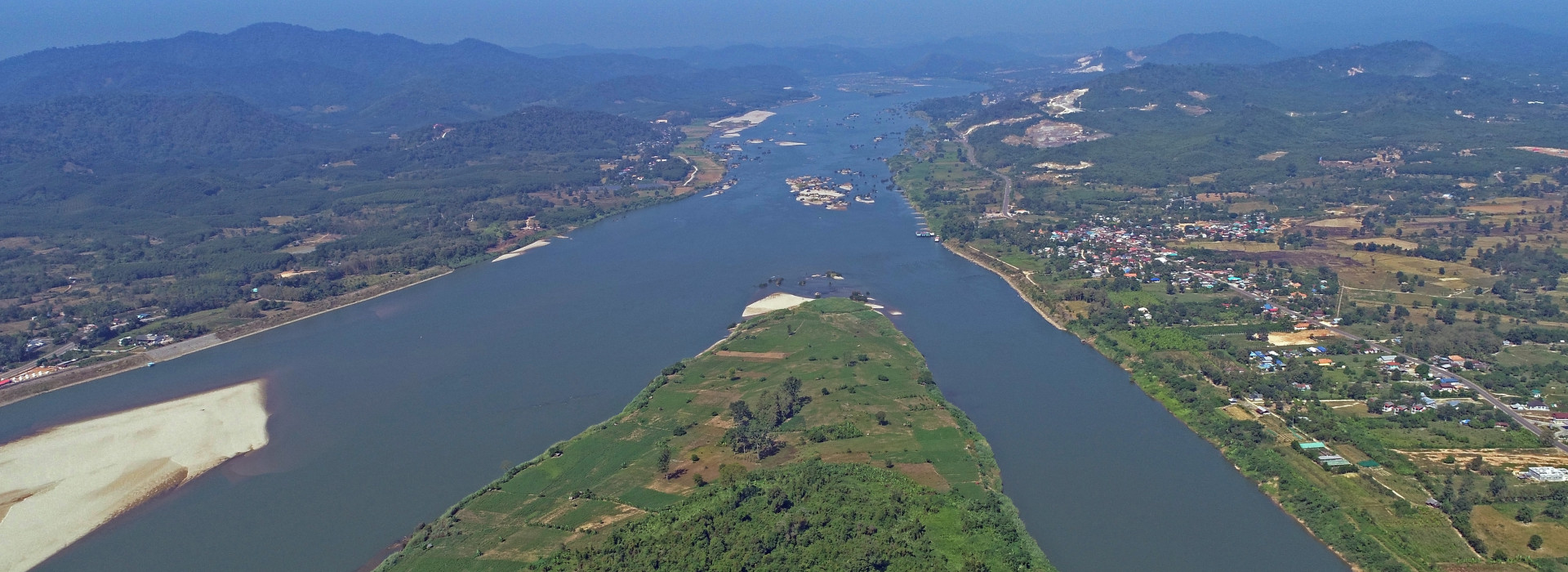Mekong River (Source: Mekong River Commission.)
Authors: Sam Tran and Alana Ballagh
The impacts of climate change and hydropower dam construction along the Mekong River and its tributaries will likely negatively affect Vietnam’s seafood exports to the United States, which totaled $330 million in the first quarter of 2024. These pressing environmental challenges call for continued US-Vietnam cooperation on climate adaptation, resilience of fisheries, and diversified aquaculture, particularly in the Mekong Delta.
Vietnam’s Seafood Production in the Mekong
The Mekong River, a transboundary river that starts in China and runs through Myanmar (Burma), Thailand, Laos, Cambodia, and Vietnam into the South China Sea, is the world’s largest inland fishery. The river’s annual haul of 2.6 million tons of fish makes up almost 25% of global freshwater catch.
The Mekong Delta in Vietnam is the river’s most productive area for both brackish and freshwater aquaculture. In the Mekong Delta, the combination of high tidal fluctuations along the coastal areas, the river’s swift currents, and vast freshwater surface areas limit pathogen exposure for the indigenous catfish, or pangasius, among other species, and provide favorable conditions for aquaculture. As a result, the Delta hosts 70% of Vietnam’s land designated for aquaculture, typically producing commercial shrimp, Indian carps, tilapia, catfish, and freshwater prawns, and contributing to Vietnam’s goal to increase aquaculture production and seafood exports.
In 2022, seafood constituted about 72% of Vietnam’s animal product and foodstuff exports to the United States, valued at about $2.27 billion. In the first quarter of 2024, Vietnam’s seafood exports to the US grew from $284 million to $330 million and over the last decade, seafood imports from Vietnam to the United States have increased from about 240,000 tons in 2013 to 350,000 tons in 2023.
Data Source: NOAA Fisheries from the U.S. Census Bureau, Foreign Trade Data Series (Foreign Trade Parameters: Imports, Annual, 2013-2023, Vietnam, Product, Select all products, Totals by Year/Country). Graphic created by Alana Ballagh and Sam Tran.
The increase in Vietnamese seafood exports to the US reflects American consumers’ growing demand for seafood. Between 2021 and 2022, US per capita fish and shellfish consumption increased 31% from 15.6 pounds to 20.5 pounds, according to the National Oceanic and Atmospheric Administration (NOAA) of the Department of Commerce. To meet rising demand, the United States imported over $2 billion worth of seafood from Vietnam out of the $31 billion of global imports in 2022. Ports in New Orleans, Los Angeles, and New York City import the highest amounts of Vietnamese seafood, with catfish and shrimp being dominant products.
Data Sources: NOAA Fisheries from the U.S. Census Bureau, Foreign Trade Data Series (Foreign Trade Parameters: Imports, 2023, Vietnam, Product, select all products, Totals by Year/Country/Customs District) and United States Census Bureau MAF/TIGER geographic database, Graphic created using qGIS by Alana Ballagh and Sam Tran.
The Mekong Delta plays a dominant role in Vietnam’s seafood exports, as four of Vietnam’s top five seafood export provinces — Ca Mau, Soc Trang, Ho Chi Minh City, and Dong Thap — belong to this region. As the Delta produces most of Vietnam’s seafood, most notably catfish, any changes to the Mekong River will very likely affect the quality and quantity of seafood to the US.
Data Sources: General Statistics Office of the Government of Vietnam: Agriculture, Forestry, and Fishery, Viet Nam – Subnational Administrative Boundaries from the COD – Subnational Administrative Boundaries data series, and the Department of Survey and Mapping, Ministry of Natural Resources and Environment –Vietnam from Open Development Mekong: Vietnam Open Development Data. Graphic created using qGIS and Canva by Alana Ballagh and Sam Tran.
Environmental Challenges in the Mekong
Current wild capture fisheries and aquacultural industries in the Delta face various environmental challenges, all of which negatively impact fisheries production and thus jeopardize Vietnamese exports to the United States. Upstream hydropower dam construction along the Mekong River and its tributaries are negatively impacting water flow levels, fish migration, and sediment transfers, while climate change has increased drought severity and frequency.
River infrastructure development along the Mekong, while contributing to regional economic development and renewable energy targets, disrupts natural fish migration patternsisrupts natural fish migration patterns. This in turn changes spawning behaviors and habitat quality that leads to a decline in fish capture. While some hydropower dams include fish passages designed to mitigate dam impacts on fish migration, experts argue fish passages are not effective for large dams along the Mekong. Furthermore, the water restrictions and releases of upstream dams alter the timing and volume of the river’s natural flow regime, which weakens the flood pulse and contributes to the decline in freshwater flow, leading to increased saline intrusion in aquacultural areas and a subsequent decline in fish production. Such hydrological challenges compound existing threats of illegal, unreported and unregulated fishing (IUU), deforestation leading to shrinking fish habitats, and water pollution in the Mekong.
Climate impacts exacerbate these conditions by increasing the severity of flooding during the rainy season and drought during the dry season. In 2020, the combination of hydropower dam construction and drought conditions came to a head as Chinese dams withheld water and worsened the existing drought in the Delta, impacting irrigation and thus agricultural and aquacultural production. Adversely, China’s section of the upper Mekong experienced high to average precipitation levels in 2019, and the unprecedently high levels of water held back by Chinese dams could have alleviated downstream countries’ drought conditions the following year. China has built the largest dams along the mainstream Mekong—as of 2020, the Xiaowan Dam and Nuozhadu Dams store about 50% of the Mekong Basin’s active storage. As of 2024, Laos hosts the highest number of hydropower dams along the Mekong and its tributaries, albeit these dams are much smaller than those upstream, followed by Vietnam.
Vietnam’s Climate Change Responses
Vietnamese authorities are aware of climate change and its effects on the Mekong’s traditional agricultural and aquacultural sectors. In 2017, Vietnam established a subcabinet-level Department of Climate Change and passed Resolution No. 120 /NQ-CP on the Sustainable and Climate-Resilient Development of the Mekong Delta. In 2021, Vietnam adopted a National Adaptation Plan (NAP) detailing climate change threats and responses through 2030. The NAP’s priorities include adapting natural, economic, and social systems, and developing tailored solutions for the Mekong. Further, to address saltwater intrusion during the dry season and rising sea levels because of climate change, the Mekong Delta’s urban development master plans changed their language from just “living with floods,” (sống chung với lũ), a common phenomenon during the monsoon season roughly from August and November, to “proactively living with floods, submersion, brackish water, and saltwater” (chủ động sống chung với lũ, ngập, nước lợ, nước mặn). Vietnam is also looking for solutions to “living with drought and salt intrusion” (sống chung với hạn, mặn) in the Mekong during the dry season.
Diversification beyond traditional products of rice, freshwater shrimp, and fish is one of Vietnam’s “adaptation” priorities on the Mekong. Vietnam has aggressively promoted the “rice-shrimp” (lúa-tôm) farming model in Mekong provinces, with financial support from international organizations, including the World Bank and the Asia Society for Social Improvement and Sustainable Transformation, and private sector companies as Cargill.
The rice-shrimp model involves small-scale farmers [using] fresh water from the rainy season for growing rice. During the dry season, farmers raise black tiger shrimp using the brackish water in the rice fields. By minimizing the utilization of inorganic fertilizers and pesticides, this model produces safe products of high quality and is praised for increasing gender equality in Mekong-related decision-making.
By making use of natural tidal cycles or crops, the model does not require feed or chemicals. However, as shrimps are very sensitive to bacterial diseases, farmers often use widely available and underregulated antibiotics that can contaminate rice crops. Antibiotic contamination of soil leads to an accumulation of antibiotics in rice and rice-based food products and further selection of resistant bacteria within the food chain. Antibiotics discharged from shrimp farming also hold negative impacts on water sources, agricultural health, and overall biodiversity. Ecologists studying the Delta are thus concerned these policies will bring long-term disease and biodiversity, outweighing the short-term economic benefits.
To best address environmental challenges and support the long-term sustainability of seafood production, Vietnam should prioritize region-specific research on sustainable aquaculture solutions, develop publicly available climate risks assessments for the Delta’s fisheries and aquaculture systems, and revere the decline of fish stocks. The Mekong-US Partnership Track 1.5 Policy Dialogue on Fisheries, Agriculture, and Food Security, hosted over March 18-19, 2024, in Ho Chi Minh City, produced relevant policy recommendations for fisheries management and policies. The Stimson Center and the International Union for Conservation of Nature (IUCN) hosted the event. Their subsequent summary report calls for Mekong governments to partner with universities and research institutions to conduct joint research with local people to inform policymakers and communities of climate risks and potential interventions, collaborate to protect freshwater fish habitats from destruction and pollution, and strengthen key infrastructure to increase supply chain resilience to climate shocks. The policy dialogue also highlighted opportunities for US – Vietnam collaboration on Mekong issues, specifically calling for technical and financial support to expand expertise on more sustainable practices amongst farmers, for habitat restoration, and to standardize monitoring of daily fish catch, fish larvae, fishers’ income, and economic valuation of freshwater fisheries.
US-Vietnam Relations in the Mekong: Past Cooperation and Future Opportunities
At a June 2024 conference hosted by the University of Law, Ho Chi Minh City (ULaw), experts identified differences in each Mekong country’s resource management policies as the most challenging factor in the Mekong. The United States has long demonstrated interest in and designed programs to promote cooperation across the Mekong sub-region. Most recently, on June 27, 2024, the Mekong River Commission (MRC), an inter-governmental organization between Cambodia, Laos, Thailand, and Vietnam, and USAID launched their new Mekong Basin Partnership, which aims to strengthen transboundary coordination and management of water and related resources. This partnership builds upon the Mekong-US Partnership (MUSP), which includes numerous projects focused on natural resource governance processes, climate resilience, education, gender equity, and renewable energy security, and the former Lower Mekong Initiative.
Climate change and sustainability issues in the Mekong receive bipartisan attention. During his visit to Vietnam in May 2016, President Barack Obama committed the US to increase capacity-building efforts under the US-Vietnam Climate Partnership in the Mekong River Delta. In 2017, President Donald Trump reaffirmed US assistance for mitigation and adaptation measures in the Mekong and US support for cooperation between Mekong River Commission (MRC) members. In her August 2021 visit to Vietnam, Vice President Kamala Harris announced a Mekong Delta Coastal Habitat Conservation program supported by USAID, IUCN, and the Vietnamese Ministry of Agriculture and Rural Development (MARD). The $2.9 million project was launched in March 2024 and aims to reduce threats to coastal biodiversity and fisheries and strengthen coastal resilience in the Mekong Delta, in partnership with Vietnamese stakeholders such as provincial authorities; businesses; management boards of marine protected areas; development partners; and fishing communities. This is one of the most visible USAID projects specifically targeting fisheries and biodiversity in the Mekong.
Programs on climate resilience in the Mekong benefits the US markets as US-Vietnam trade relations grow. In September 2023, the US and Vietnam upgraded their relationship to a Comprehensive Strategic Partnership (CSP). Under the CSP, Vietnam ranks the United States as one of the country’s most important partners, equal to China and Russia, in Vietnam’s hierarchy of diplomatic relationships. However, the United States designates Vietnam a “nonmarket economy” (NME) as the Department of Commerce considers Vietnam as not operating on market principles of cost or pricing structures. While the US granted Vietnam normal trade relations in 2001 but in 2002, designated Vietnam an NME during antidumping investigations into Vietnamese catfish exports. The investigations aimed to prevent Vietnam from practicing “dumping” policies which set Vietnam’s export prices for a product below its domestic prices. Currently, US shrimp and fisheries interest groups want to maintain the designation while some experts and members of the private sector are calling for a change. Commerce rejected Vietnam’s request to be removed from the NME list.
Should Commerce redesignate Vietnam as a market economy, Vietnam’s dumping margin will stop being compared to US sale prices from a comparable third country (considered a market economy and economically comparable to Vietnam), but rather will be based on Vietnam’s data. Vietnam’s export goods will be treated equally as export goods from other countries and will likely not be subjected to US anti-dumping duties. Further, Vietnam will stand in a stronger position to negotiate international trade deals.
Irrespective of the NME designation, Vietnamese seafood exports to the United States have grown over the last decade. The Mekong’s pressing environmental challenges, which impact fisheries and aquaculture production, thus hold downstream impacts for US consumers, particularly as US demand for seafood grows and Vietnam aims to meet this demand to meet its own export goals. Widespread attention by both US policymakers and Mekong experts on the Mekong Delta makes clear the region is important for both countries. Increased efforts to support fisheries and aquaculture resilience are necessary, particularly as Mekong countries continue to build hydropower dams and climate impacts grow increasingly severe.
Sam Tran is a Young Professional Program participant at the East-West Center in Washington and recently graduated from University of Massachusetts Amherst with a B.A. in Political Science. He previously interned with the US-Asia Institute and worked as a research assistant the UMass Amherst Poll. His research interests include Saigon’s architecture and history, Vietnamese music, and legislatures.
Alana Ballagh is an incoming graduate student in the Energy and Resources Group at the University of California, Berkeley pursuing an MS in Energy and Resources, and a Young Professional at the East-West Center in Washington. Previously, she was a Fulbright English Teaching Assistant in Vientiane, Laos, and Southeast Asia program intern with the Stimson Center. She received a BA in Environmental Studies and Political Science from Swarthmore College.

 Politics & Economy4 years ago
Politics & Economy4 years ago
 Politics & Economy1 year ago
Politics & Economy1 year ago
 After 19751 year ago
After 19751 year ago
 ARCHIVES5 years ago
ARCHIVES5 years ago
 Society & Culture5 years ago
Society & Culture5 years ago
 Politics & Economy4 years ago
Politics & Economy4 years ago
 Politics & Economy5 years ago
Politics & Economy5 years ago
 Politics & Economy4 years ago
Politics & Economy4 years ago







